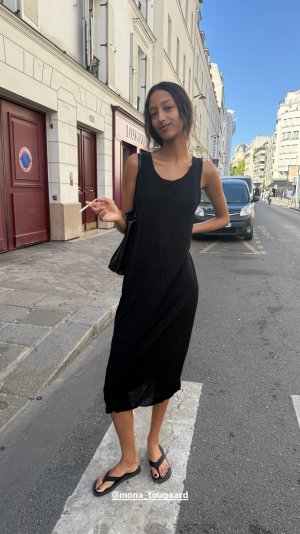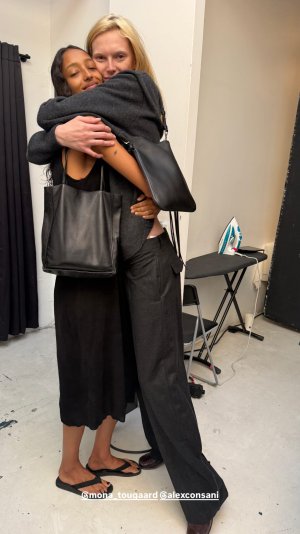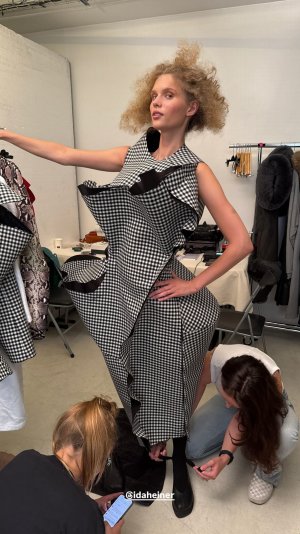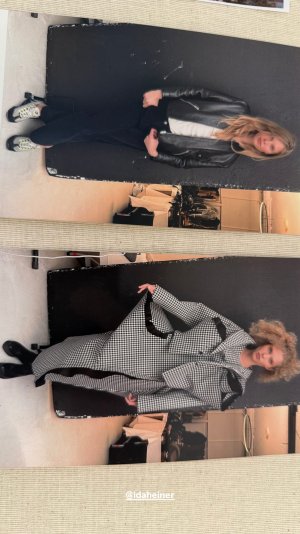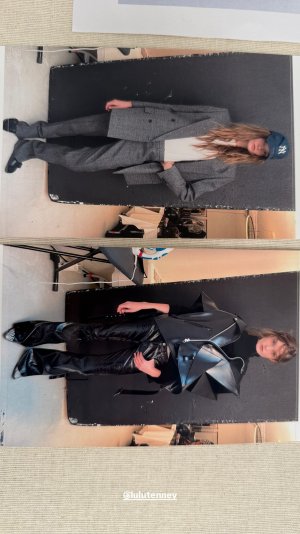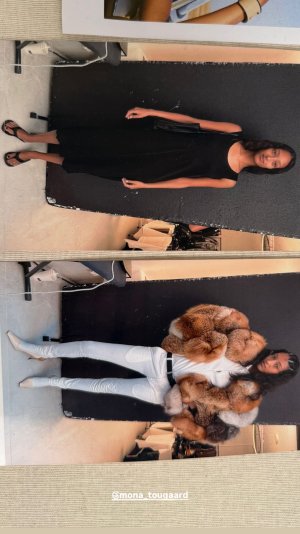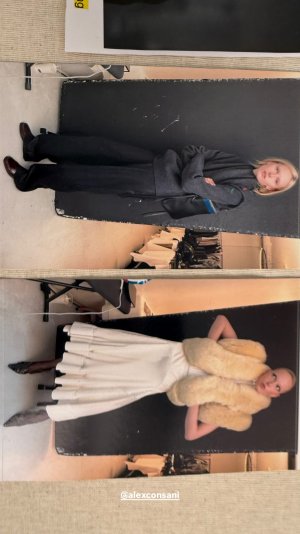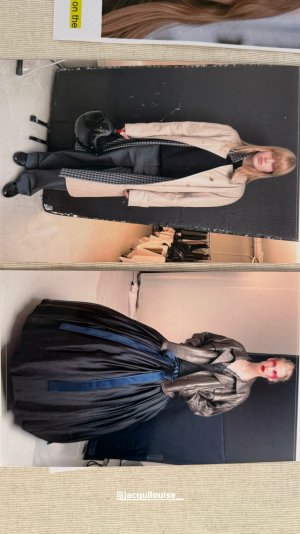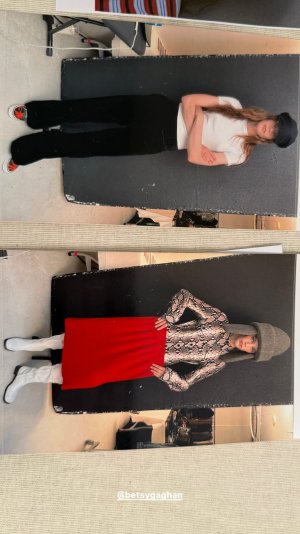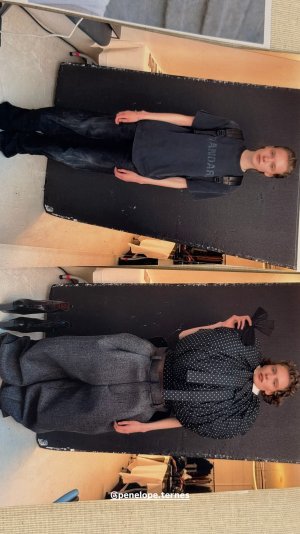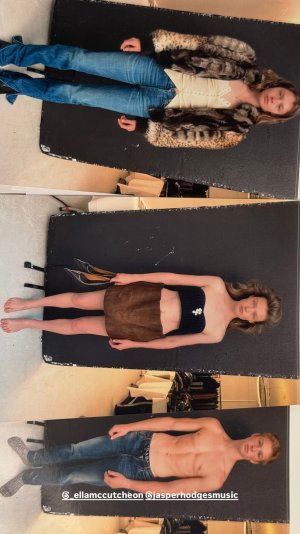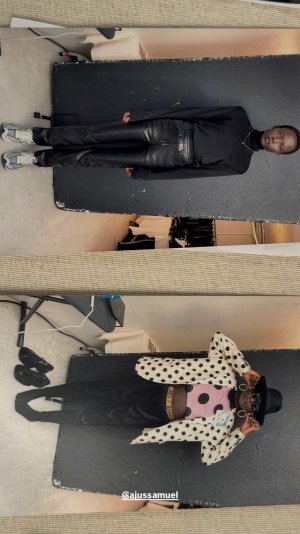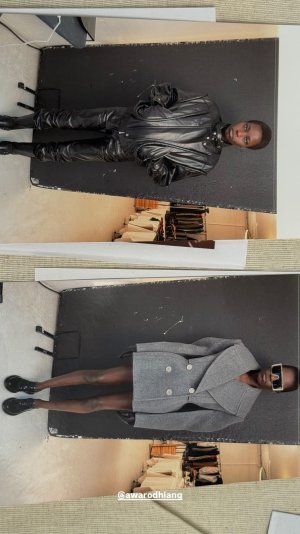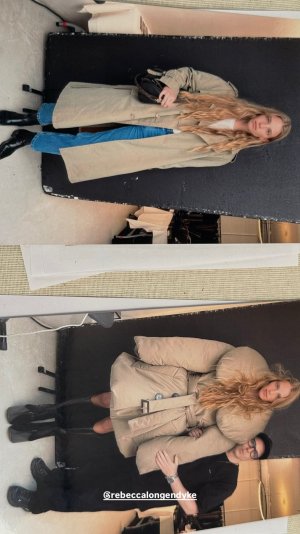Is there a translation of Carine's interview in English somewhere?
A silhouette on high heels, a lock of hair that covers her face... A figure that can be drawn in a single stroke. Carine Roitfeld is a fashion authority, instantly recognizable. A fashion editor with incomparable style, she created the most iconic spreads for Vogue Paris, where she was editor-in-chief from 2001 to 2011. Always a bit of a dissident, she cultivates this form of dissonance in her images, where an air of controversy lingers. It's her signature, her freedom; she reigned over p*rn chic with Tom Ford, a huge influence that made her a star at the dawn of the year 2000. Today, she continues her adventure with her own magazine, CR Fashion Book, and navigates this constantly evolving world with sincerity. Because, like all these great figures on the front row, she has fashion in her blood and continues to whisper in the ears of designers, accompany photographers, and support the models she adores. With Claire Thomson-Jonville, she shares her unwavering love of fashion and looks back on her Vogue years, a strange family, a little turbulent, certainly, and always inspiring fantasy.
Claire Thomson-Jonville You have a career whose longevity and success are exemplary. What still surprises you about fashion?
Carine Roitfeld It always surprises me that people think I've been in the industry for a very long time, which is basically true. I don't imagine myself like that. Every time I start a job, I feel like I'm starting from scratch. I like new experiences; for example, I'm very happy that Dior entrusted me with curating the exhibition at the UBS House of Craft in New York. And there are still so many things I haven't done. There are still photoshoots, and I continue to contribute to fashion shows. One of my dream jobs is to work for Victoria's Secret. I don't understand why I've never been asked. It's so me! I'm taking advantage of this interview to express this "fashion wish.”
Claire: You're the author of legendary fashion series. How do you still find excitement, how do you renew yourself?
Carine: I'm not sure I renew myself, because I have a vision, an eye, a way of seeing women and poses that are all my own. I've changed photographers a lot, because that's half of a vision; they bring a different perspective. But I'm still just as excited when I arrive on a shoot even if it's getting harder and harder to get up early in the morning. You have to be there from the first thing to set the mood, a coffee, a cigarette. To guide the team, the photographer, and the models…
Claire: You embody a seductive and very specific way of fashion. When you look back on your career at Vogue Paris, what moment do you think most characterizes your aesthetic?
Carine: One of my last issues, the magazine's 90th anniversary. When I arrived at Vogue, I loved the 1970s and 1980s, which were no longer relevant in the 2000s. I've always loved the aesthetic of Jeanloup Sieff, Guy Bourdin, Helmut Newton, all those cult photographers. I had in mind to revive those years. For this special issue, we
created a supplement where we mixed photos from my generation in a mirror image with those from those eras.There were previously unseen photos of Newton, Mario Sorrenti… It was very coherent, very fluid. A success! It reassured me. They all had the same message, the same point of view. And then this incredible party, a masked ball that's a true French tradition, the men wore tuxedos, everyone had a mask. The cover, by the way, was Lara Stone in black and white, wearing a mask. I fought for this cover!
Claire: How did you manage to resist and impose your beliefs?
Carine: I always stood up for myself, I always insisted. I started at ELLE magazine, and if you wore Dr. Martens in the 1980s, the spread was rejected outright. It took me a while. I was lucky to have been defended. People protected my madness. Like Tom Ford. In Gucci campaigns, the men wore thongs, or that G shaved on a woman's pubic bone... You had to be protected! When I left Vogue, I was very lucky to meet Karl Lagerfeld, a true guardian angel with whom I worked on his campaigns for 10 years. In this industry, you always need protection. I used to amuse him a lot! We talked about underwear voices. Do you know what an underwear voice is? Tom Ford has an underwear voice. An extremely sexy voice.
Claire: Like Karl Lagerfeld and Tom Ford, your look is your signature. A protection?
Carine: Yes, that's why I created my own look. When I arrived at Vogue, I needed an editor-in-chief look. Skirt, high heels, tight coat. Carine's look was developed at this magazine. To give me strength. I'm not as brilliant as Karl and Tom. I don't have much wit or the art of conversation. In this outfit, people look at me differently. I've become a character. People tell me that today, I'm cooler than before. I've stepped out of my somewhat rigid uniform. Yes, it's a kind of armor, just like Anna Wintour and Karl.
Claire: You've always been innovative in the way you push boundaries.
Carine: I don't do anything to offend, I don't do anything to overstep the boundaries of propriety. It's despite myself. I never deliberately wanted to shock. It's in my head. It's like psychotherapy, but I haven't yet found the reason! This kind of rebellion, I achieved it through my images. Spontaneously, in fact. I’m a virgin, there's the wise virgin in me; that side is my children and my responsibility as a mother. I also love models; I’ve always been maternal with them. When they posed nude in heels, it was always with their consent, "Are you sure? I don't want your mother to call me, and you're under no obligation.” And the whole team created a reassuring atmosphere. And then there’s the foolish virgin, those are my photos. People thought I was a nymphomaniac during Gucci's time, they also called me the queen of chic p*rn. I liked that. All those words of rebellion made me happy.
Claire: When I look at the archives, I tell myself that there are certain images that are impossible to achieve today.
Carine: Models were freer with their bodies. Today, we have to think more. A misstep we don't even imagine can ruin a career. When I was young, my mother wore fur, ocelot. She didn't realize it since no one said it was wrong. She understood with Brigitte Bardot. She threw hers in the trash. We didn't know that smoking was wrong. I also opened people's eyes. At Vogue, I was also the first to have a Black transgender model pose in a short skirt with a beard. No one said anything. I like to clash cultures. Like that series with Michèle Lamy. Her gold teeth, her tattoos, her henna... It was magnificent to cover her in diamonds. Lara Stone as a nun with jewels. Or that high jewelry series with Crystal Renn eating pasta and octopus. It's impossible to do that anymore, like in Newton's day. I was called in a lot by management! But I was supported by the boss, Jonathan Newhouse. When I had a problem, I went to him and it went through. It must also be said that Vogue was doing well. And I've always respected the brands, and I never have any advertising problems with the houses.
Claire: The digital age and social media have considerably reduced this provocation, where nudity and breasts weren't a problem.
Carine: Whatever my work, I've always added a touch of humor. I remember that series where we simulated anti-fur associations throwing paint on clothes. Or when I posed a pregnant Lily Donaldson with cigarettes in her hand—she wasn't, I should add! She threw the baby in the air, a doll, still holding her cigarettes. I received a lot of insults. I thought it was funny to say "no smoking" with this pregnant girl holding two cigarettes. Of course, you don't smoke when you're expecting a baby or around a pregnant woman! It was derisive. People have less and less sense of humor. You never know, you have to think. I remember a series with Inez & Vinoodh, in Marrakech: three girls in luxury clothes. I was looking for a common thread in the pages, we bought headscarves that they wore in different ways. I was warned because they thought it was offensive to religion. Finally, it was published. No reaction, except for a letter from a Muslim women's association thanking me for giving them ideas on how to wear headscarves. The worst was a series with Steven Klein. We photographed Lara Stone in all colors: red, white, black, and one where she looked very tanned. I got killed! I was accused of blackface. But it wasn't. And we didn't expect it. From now on, we have to be on our guard because we never know where it will come from.
Claire: How do you navigate the world of fashion, a sometimes murky environment?
Carine: I don't look back. I've stayed true to what I love. I have a wide range of expression; I can be very classic or extravagant. It's still me, deep down. It's instinctive. It's a difficult and cruel profession. When you get older, you can't stop there, staying fixed in the fashion icon; that's not enough to work. You have to question yourself, but not your taste. Now, I respect things more than before. But if it's a little dissonant, I'll always do it. I remember a haute couture series at the Agricultural Show. You have to be crazy! You have to be French! Why not tackle a couture subject there? They're both symbols of France. Another series at Mont-Saint-Michel, I wanted to do couture Breton women... in swimsuits. We photographed them in front of them because we weren't allowed inside, a matter of decency. They wore traditional headdresses that came from different regions of France. I was happy to show off these hats from the provinces of France.
Claire: You're very active on Instagram, and we can tell you really enjoy it.
Carine: It's funny, and I don't want it to be taken seriously. I like humor and I have a sense of humor. I don't show my vacations, it's not interesting. But rather when I have perfume in my eye, my crooked back. It makes you more human. Today, people either love it or hate it, and you have to give of yourself. People prefer to see me brushing my teeth, in bed, walking my granddaughter than my latest covers. At first, people don't understand that we're talking to millions of people. I show my tattoos, they love them, and no one criticizes me anymore when I have a cigarette, but they make comments if I have a plastic bottle in my hand. I'm friendly and not cold.
Claire: How do you see the role of a stylist today?
Carine: People have a high opinion of themselves. I don't like #stylebyme, I find it pedantic. I never use it, I don't sign it, I already have my name on the cover of the CR Fashion Book. A part of creativity has disappeared and we're moving towards the total look for convenience. Alastair McKimm, Lotta Volkova, Marie-Amélie Sauvé, and Ib Kamara are good stylists. I like to see a well-styled subject, and I like to say so when I like it.
Claire: You remain the queen of fashion editors!
Carine: You wear a crown when you're editor-in-chief of Vogue because it's a huge power and everyone loves you. When you leave, few people stay. It's hard to get the crown back, but I haven't had the Vogue blues. I've never stopped working, and I'm not afraid.
I laughed again and you’re so right on both of these statements.


